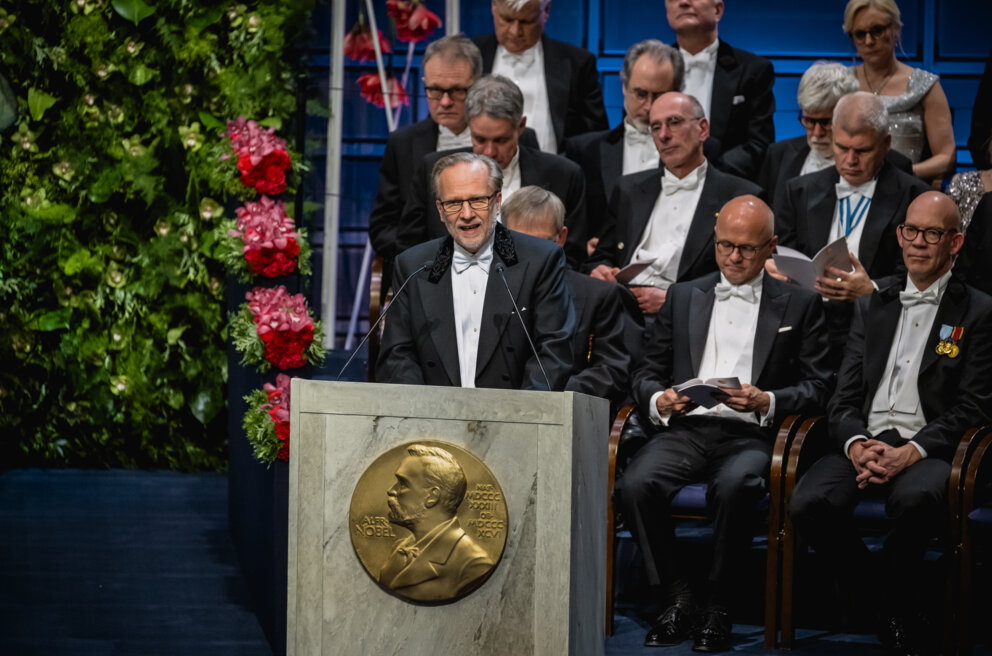Award ceremony speech

Professor Tore Ellingsen delivering the presentation speech for the 2022 prize in economic sciences at Konserthuset Stockholm on 10 December 2022.
© Nobel Prize Outreach. Photo: Nanaka Adachi
English
Swedish
Presentation Speech by Professor Tore Ellingsen, Member of the Royal Swedish Academy of Sciences, Chairman of the Committee for the Prize in Economic Sciences in Memory of Alfred Nobel, 10 december 2022.
Your Majesties, Your Royal Highnesses, Esteemed Laureates, Esteemed Laureates in Economic Sciences 2020 and 2021, Ladies and Gentlemen!
For thousands of years, the roofs of fine castles and churches have been plated with copper. Both the Concert Hall, where we are now, and the City Hall, where we shall dine and dance, have copper rooftops.
But before the party starts, please join me on a journey to the past. We land in Stockholm almost four hundred years ago, in 1624. Sweden is the champion of copper production. Since the government wants a higher copper price, it launches the copper coin.
Two decades later, wanting to raise the value of copper once more, the government introduces the copperplate coin. Instead of using silver for big payments, the government urges the use of large, minted copper plates. The 10-daler plate weighs almost twenty kilos!
It is the bulkiness of the copper currency that breaks the remaining resistance to banking. In 1657, Stockholms Banco is open for business. For the first time, Swedish merchants can deposit their currency in a bank and settle payments with the stroke of a pen. No longer need they break their backs carrying heavy copper plates around the city.
Soon, the borrowers are even happier than the depositors. Stockholms Banco starts to lend at better terms than Stockholm’s traditional moneylenders.
But already in 1660, Stockholms Banco experiences its first bank run. The government triggers the run when it suddenly decides to mint new lighter copper plates. Since older plates with the same daler imprint have a higher copper value, depositors rush to get their old plates back before someone else does. The bank must halt lending, to the distress of borrowers seeking to extend their loans. Many of them must sell assets at fire-sale prices. After a second run a few years later, the bank goes under.
What to do? Can’t deposit banks lend liberally without risking financial crises? Sweden’s solution is to start a new bank, governed by the Parliament. In 1668, with deep pockets and at arm’s length from the Government, the world’s first central bank is born.
From 1668, let us stride 315 years ahead.
In 1983, Douglas Diamond and Philip Dybvig develop a fundamental theory of banking and bank runs. The theory says that any ideal financial arrangement promises each saver instant access to her funds yet channels most of these funds to long-term projects. However, the ideal arrangement is fragile, like Stockholms Banco. Preventing bank runs requires public regulation such as deposit insurance and emergency loan facilities.
The very same year, Ben Bernanke discovers how bank failures affected the Great Depression in the 1930s. His analysis of historical records and economic statistics reveals that bank failures were costly mainly because of broken ties between lenders and borrowers, not because the money supply fell, as we believed before.
Dear Dr Bernanke and Professors Diamond and Dybvig,
When the Great Financial Crisis hit us fourteen years ago, your theories were vindicated. Where the banking system was more robust and better regulated, the crisis became milder. Recent reforms bear the imprint of your lessons. Just as copper rooftops shield us from bad weather, these good laws will shield us from financial storms.
It is an honour and a privilege for me to convey to you, on behalf of the Royal Swedish Academy of Sciences, our warmest congratulations. May I now please ask you to step forward and receive your prize from His Majesty the King.
Copyright © The Nobel Foundation 2022
Nobel Prizes and laureates
See them all presented here.
